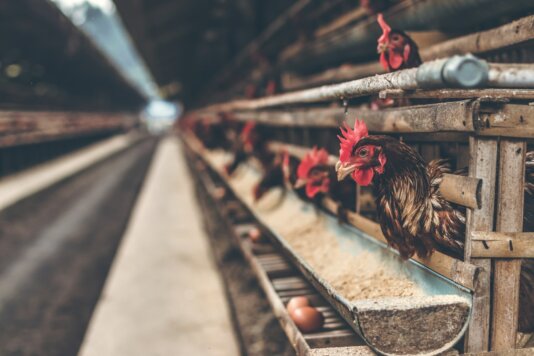- About
- Topics
- Picks
- Audio
- Story
- In-Depth
- Opinion
- News
- Donate
- Signup for our newsletterOur Editors' Best Picks.Send
Read, Debate: Engage.
| topic: | Sustainable Agriculture |
|---|---|
| tags: | #animal cruelty, #Sustainable Agriculture, #meat industry, #industrial farming |
| located: | USA |
| by: | Cathy Liss |
For the past several months, poultry industries in the US have struggled to contain a deadly strain of highly pathogenic avian influenza (HPAI) that has wreaked havoc on farmers across the country and led to the destruction, or "depopulation," of more than 40 million domestic birds.
To make matters worse, producers chose the most inhumane method available to kill these animals en masse - ventilation shutdown plus heat (VSD+), which involves cutting off the airflow in a barn and ratcheting the temperature above 104 degrees until the animals eventually die from heat stress.
In other words, they were cooked alive.
More than half of the depopulations conducted in February through May used VSD+ to kill at least 8 million birds, according to a new analysis of federal records by the Animal Welfare Institute. This is despite the serious welfare concerns associated with this method and the USDA’s stated policy that VSD+ should only be considered when other, more humane methods are not available.
Nevertheless, during the recent outbreak, killing birds over several agonising hours by inducing heat stroke has become routine, as mega industrial livestock operations aren’t equipped to dispatch massive numbers of animals quickly to control disease outbreaks.
How did we get here? Although the overall number of farms (mostly small and mid-size operations) has declined for the past several decades, more animals are raised and produced for food in the United States today than ever before. Concentrated animal feeding operations (CAFOs) confine anywhere from a few thousand to several million animals at one location, and consolidate control over production among a handful of large corporations.
Just four companies - Cargill, Tyson, JBS, and National Beef Packing - now control 55 percent to 85 percent of the pork, beef and chicken markets in the United States.
The consequences of this deeply entrenched system are glaring, especially in light of the concurrent crises of the deadliest bird flu outbreak in seven years and the COVID-19 pandemic’s unprecedented disruptions to daily life around the globe. The unchecked growth of CAFOs only intensifies supply chain disruptions and animal disease outbreaks, with catastrophic results.
In 2014-15, HPAI similarly surged throughout the country, killing 50 million birds and costing taxpayers an estimated $850 million. Following that outbreak, the USDA approved VSD+ in situations where no other method would accomplish flock depopulation quickly, yet this method is far from reliable.
During the current avian flu outbreak, records show that 71 percent of the depopulations that took place at locations confining more than 200,000 birds exceeded 48 hours. These depopulations affected 21.8 million birds, and four of the depopulations - each involving over 1 million birds - took 10 days or longer to complete.
Moreover, during the COVID-19 pandemic, American slaughterhouses became hotspots for infections - tens of thousands of workers became ill and hundreds tragically died. The rapid spread of human disease within these plants forced the temporary closure of dozens of facilities, ultimately creating a bottleneck of market-weight animals with nowhere to go.
As another example of a "too big to fail" industry that leaves little room for error, CAFOs killed millions of healthy animals by VSD+ and other methods and dumped their carcasses.
In the aftermath of these crises, it seems Big Ag has not heeded lessons learned. Rather than moving away from a large-scale, intensive production system that warehouses millions of animals in tight quarters within a single facility, the industry has instead doubled down and continued to build bigger and bigger, seemingly without consideration for preventing or responding to future animal and human health emergencies.
Simply put, this model is unsustainable. It’s time to crack down on the monopolistic practices of multinational meatpackers and corporate interests that decimate communities, squeeze out small farmers, and exploit workers and the animals under their care.
Last year, US Senator Cory Booker (D-NJ) and Congressman Ro Khanna (D-CA) reintroduced the Farm System Reform Act, which would place a moratorium on the construction and expansion of large CAFOs.
The bill - supported by more than 100 sustainable agriculture, labor, environmental, public health, animal welfare and faith-based groups - also creates a voluntary debt forgiveness and transition assistance program to provide grants for farmers switching from the conventional CAFO model to a more sustainable, pasture-based operation or crop production.
Passing the Farm System Reform Act is a necessary first step if we hope to loosen factory farming’s chokehold on our food system, and move towards a more secure and humane way of feeding our communities.
Image credit: Artem Beliaikin.
